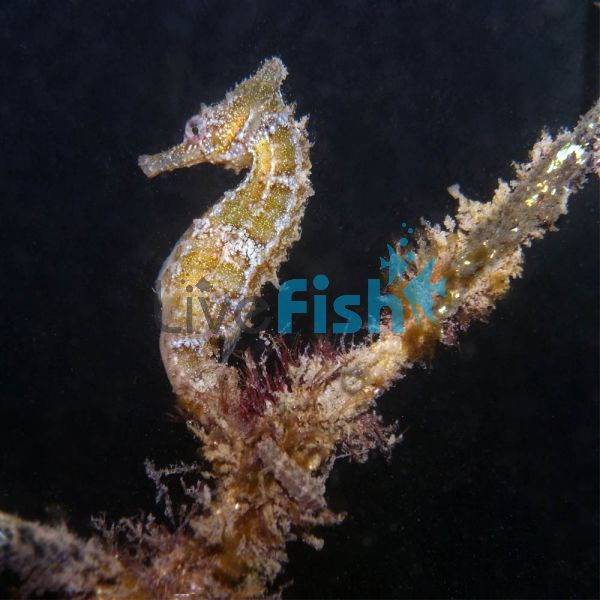White Seahorse 7cm
Seahorses are magical fish and make for great realxing marine aqarium inhabitants. The Sydney Seahorse is a peaceful slow swimmnig spcies that will be a unique addition to a seahorse aquarium.
The Sydney Seahorse usually ranges in colour from light brown to dark brown or black. Some specimens, however, are totally yellow. They often have pale, saddle-like marks on their body, and lines or bars under the snout. They can be identified by their long nose, narrow head, and moderate to high coronet. Adults can grow to a length of around 5.1 inches (13 centimetres) in length.
The Sydney Seahorse is an ovoviviparous species. The male will carry the females’ eggs in its brood pouch and fertilize them. He protects them in the pouch until he is ready to give birth to them. Up to 150 live young can be born from a brood of 100-250 embryos. This is a monogamous species that stay faithful in a mated pair.
They are found in the Southwest Pacific, around Australia and the Solomon Islands. They often inhabit shallow inshore areas, jetties, or seagrass beds. Usually between depths of 1-25 metres.
Tank Recommendations for your Sydney Seahorse
Information about this specific species is limited. However, seahorses, in general, should be kept in a tank that is at least 30 gallons (113 litres). This will accommodate an adult pair.
Seahorses should be kept in a species-specific aquarium with sufficient circulation. Tall aquariums are a better shape for these marine creatures. The height should be at least 16 inches (40 cm) or 3-4 times taller than the seahorse in the tank. They should be able to wrap their tails around a variety of ornaments or decorations. Anchoring to these items lets them rest between feedings. Suitable hitching spots include mangroves, false plants, or dead coral.
A seahorse tank shouldn’t have a strong current as they are weak swimmers. Their resting areas need to have an especially low water flow. Avoid strong lighting as this can be stressful for seahorses. Clean water is essential, and a protein skimmer is recommended.
Suitable Tank Buddies
Seahorses are extremely passive. There are certain small peaceful fish that they can cohabit with. However, they should ideally be kept in a species only tank.
Usually Compatible
Tank buddies of the same species are best companions. Seahorses can either be kept as a pair or a small group.
Sometime Compatible
Species like Gobies, Jawfish, and Dartfish will need to be monitored. Larger invertebrates will also need to be watched; small inverts should be ok though.
Rarely Compatible
Many species are unsuitable for sharing a tank with a Seahorse. Predators, active, aggressive fish, and any fish that causes stress should be avoided.
Feeding your Sydney Seahorse
The Sydney Seahorse is a carnivore. It will eat small prey whole using its snout. Suitable food products include copepods, rotifers, shrimp, krill, and plankton. Feeding should take place twice a day.
| Scientific Name | Hippocampus whitei |
|---|---|
| Care Level | Moderate |
| Common Names | Sydney Seahorse, White’s Seahorse, New Holland Seahorse. |
| Diet | Carnivore |
| Fish Family | Syngnathidae |
| Lifespan (years) | 5 |
| Max. Length (cm) | 13 |
| Min. Tank Volume (l) | 113 |
| Origin | Southwest Pacific; Australia, Solomon Islands. |
| Reef Safe | Yes |
| Sociability | Peaceful |
| Venomous | No |
| Water Conditions | 22.2-25.5° C (72-78° F), dKH 8-12, pH 8.0-8.4, sg 1.021-1.025 |




